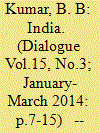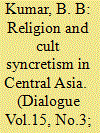|
|
|
Sort Order |
|
|
|
Items / Page
|
|
|
|
|
|
|
| Srl | Item |
| 1 |
ID:
129400


|
|
|
|
|
| Publication |
2014.
|
| Summary/Abstract |
When one hears about the sad demise of a life just beginning to bloom, and yet another made dead while living by robbing her childhood and future dreams, both displaying extreme beastliness. The shock and surprise which the nation experiences, knows no bound. Usually such sad happenings are followed by angry protests, rallies, dharnas and bandhs, which is quite natural. Recent incidents, which have shocked the nation, are the murder of a young, just 19 year old, boy and the rape of a 13 year old girl in the capital city of this unfortunate country. The boy, Nido Tania, was from Arunachal Pradesh and the girl from Manipur. The question is: how long this nation of 120 crore people shall tolerate the beastliness of say, a few thousand goondas? And again, why such heinous acts of murder and rape continue to recur even after repeated resolve, at the highest level, to control the deviants?
|
|
|
|
|
|
|
|
|
|
|
|
|
|
|
|
| 2 |
ID:
129408


|
|
|
|
|
| Publication |
2014.
|
| Summary/Abstract |
The famous Nicolo seal with a four-armed deity, having in his four hands a wheel, a mace, a ring like object and a globular thing, with a devotee standing by his side in respectful pose with folded hands, was
described by Cunningham in the Numismatic Chronicle as Vishnu, the deity and King Huvishka, the attending devotee. The Kushana identity of Huvishka was identified because of the affinities of headdress and garment.1 Right interpretation of the seal, however, was possible only after correct decipherment of the inscription by R. Ghirsman.2 The inscription, according to him, was in Tokharian script and in Tokharian language; it contained the names of Mihir (the Sun God), Vishnu and Shiva. But the devotee, according to him, was some unknown Hapthalite Chief, rather than the Kushana King Huvishka. Any way, irrespective of the identity of the devotee, the use of Tokharian script and language made it clear that composite cult of Shiva (Siva), Vishnu (Visnu) and Mitra was popular in Central Asia.
|
|
|
|
|
|
|
|
|
|
|
|
|
|
|
|
|
|
|
|
|